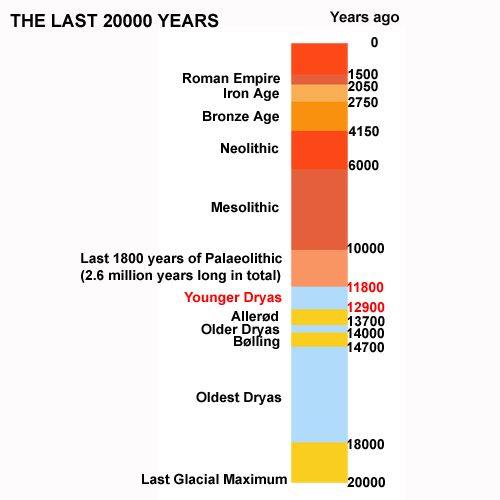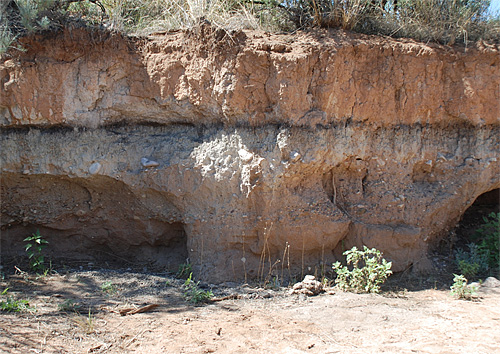Catching up with the Younger Dryas: do mass-extinctions always need impacts?
Posted on 24 March 2012 by John Mason
Perhaps the most curious aspect of Earth's emergence from the last glacial maximum, a process that began just under 20,000 calendar years ago, was the Younger Dryas, (named after the pollen-record of the beautiful plant that is now grown in many rock-gardens - my Grandfather grew it and I did in my time): a period beginning 12,900 years before present and lasting over 1,000 years during which the planet, and especially the northern hemisphere, cooled rather abruptly and, at high latitudes, glacial re-advance commenced. Ending even more abruptly, perhaps in as little as a few decades, it marked the final cold snap before the advent of the more temperate conditions of the Holocene Period. So: what caused it?

above: the Younger Dryas in the context of the past twenty thousand years. The later (post-Neolithic) periods refer primarily to Western Europe.
The prevailing hypothesis for some time (Broecker, 1989) has been that the rapid cooling was triggered by a major pulse of fresh water entering the North Atlantic. The mechanism for this mega-flood involved a huge glacial lake, Agassiz, which was situated in a central position within the North American continent and which was fed by melt-waters from the shrinking Laurentide ice-sheet to the NE - in other words it was a proglacial lake. The massive fresh-water pulse caused either a significant reduction or a complete shutdown of the North Atlantic Conveyor, the oceanic current that brings warm water northwards from the tropics. With this source of heat cut off, a temporary return to colder conditions, especially at the mid to high latitudes, set in.
However, there have been some problems with this hypothesis and its proposer even commented in 2006 that “our inability to identify the path taken by the flood is disconcerting”. That problem appears to have been solved by Murton et al (in Nature 464, 2010), who identified the path of a colossal flood down into the Mackenzie River and out across the Canadian Arctic Coastal Plain into the Beaufort Sea. How this mega-flood affected the North Atlantic Conveyor remains unclear.
In the light of such problems, other hypotheses have been put forward, many of which have attempted to address other issues that apparently occurred at the same time, amongst which there is the Younger Dryas Impact Hypothesis, which suggests that one or more major extraterrestrial impacts triggered the cooling. This has been a controversial idea: catastrophe hypotheses, including that surrounding the the K-T extinction event, are always controversial. The Younger Dryas Impact Hypothesis has, however, continued to generate interesting if often inconclusive research.
The research is focused on one particular geological marker horizon that was deposited at the start of the Younger Dryas. Already known to be present at over fifty sites across North America, it is an unusual layer of dark grey to black carbonaceous silty clay (containing up to 8% carbon): it is referred to as the “black mat”. In some cases, such as at Murray Springs in Arizona, it directly overlays Clovis remains including hearths, tools and butchered mammoth bones.

above: sediments spanning the Younger Dryas boundary in Arizons. The 'black mat" is the dark horizon at mid-height.
It contains an assemblage of unusual minerals that were described in detail by Firestone et al (PNAS 104-41, 2007), leading to their proposal that one or more large, low-density extraterrestrial objects had, 12,900 years ago, exploded over North America, triggering the Younger Dryas cooling. The reported markers consisted of the following: nanodiamonds, magnetic microspherules (glass, silicates, spinel or metallic), 0.01-0.25 mm in size; magnetic grains (silicates with included magnetite), 0.001-0.5 mm in size; charcoal; soot; carbon spherules, 0.15-2.5 mm in size; glassy carbon in pieces to several cm; fullerenes with helium isotope ratios reportedly typical of extraterrestrial material and elevated iridium and modestly elevated nickel levels.
Jumping forward to 2009,and Kennet et al (PNAS 106-31) reported the finding, from an organic-rich Younger Dryas boundary-layer at a new site in California, of shock-synthesised lonsdaleite - a nanometre-scale hexagonal variety of diamond only found in meteorites and at impact-craters, with associated nanoscale n- and cubic diamonds, plus charcoal and soot. Yet, that same year, an independent team - Surovell et al - published a study (PNAS 106-43) that reported that they had failed to replicate the results of Firestone et al. Furthermore, Haynes et al reported the findings (PNAS 107-9) of another examination of the the Murray Springs site. Their conclusion: "From the data presented here we find no compelling evidence for a cosmic catastrophe at the Murray Springs Clovis site." They also note, "We do not observe a LYDB Ir anomaly relative to the local geological background."
Firestone et al responded in 2010 (PNAS 107-26): "We are puzzled by the conclusion of Haynes et al that they “failed to ?nd iridium ..... anomalies.”... They reported extremely high concentrations of Ir ranging from 31 to 64 ppb in two magnetic fractions from across the YDB. Their values are as much as 34 times higher than we reported but within the range of values at other YDB sites and >1,000 times terrestrial abundance (0.021 ppb). These Ir measurements contradict those of Paquay et al, who failed to observe large Ir anomalies at Murray Springs." In the same volume, Haynes et al reaffirmed their stance: "We consider our iridium analytical results of 64 ppb and 31 ppb to not be anomalous because they are less than the 72 ppb for magnetics from the modern stream bed."
However, Paquay et al (PNAS 106-51) noted: "......elevated Ir concentrations alone are insufficient to demonstrate a significant extraterrestrial component. As described below, the relative abundances of platinum group elements and 187Os/188Os ratio provide a more robust test of the presence or absence of extraterrestrial matter in BA/YD samples." The Ir levels they detected at Murray Springs and elsewhere were low - although they do not appear to have analysed magnetic fractions. Osmium isotope ratios were, they suggested, not indicative of an impact at the basal Younger Dryas horizon. They went on to suggest that nanodiamonds were not necessarily formed by impacts but could have been produced e.g. by intense wildfires, a point already suggested by van der Hammen and Geel writing in the Netherlands Journal of Geosciences in 2008 (87-4, 359-361).
These variations in findings and interpretations led to a 2010 news focus article in Science (329: 1140-1141) that had the headline, “Mammoth-killer impact flunks out”! The summary of the piece was as follows:
“Did a continent-searing comet impact wipe out the mammoths and other great beasts? Impact specialists have now weighed in on that widely publicized possibility. Their verdict: There never was a mammoth-killer impact......But core supporters of the impact scenario are sticking to their guns.”

above: the Younger Dryas is certainly generating a lot of literature!
The same year, a “black mat” - complete with supposed impact-markers, was described by Mahaney et al (Geomorphology 116, 45-57) from the Venezuelan Andes.
2011 saw Pinter at al publish 'The Younger Dryas impact hypothesis: a requiem' (Earth Science Reviews, 106, 3-4, 247-264). Tian et al (PNAS 108-1) presented their investigations of the well-defined Younger Dryas basal layer at Lommel in Belgium - here forming a black band in otherwise buff sediment. Samples were examined by transmission electron microscopy and carbon isotope studies. They wrote:
"Our findings confirm, and in fact reveal more direct proof than the earlier studies, the existence of diamond nanoparticles also in this European YDB layer. No such particles are found in the overlying silt and clay or in the underlying fine sands."
But, in conclusion:
"Because no hexagonal diamond (Lonsdaleite) could be identified a shock-induced mechanism is unlikely to be involved in the formation of the crystalline carbon material in the present layer.... As a final conclusion it should be stated that the present variety of crystalline structures observed in the black Younger Dryas boundary in Lommel does not provide sufficient evidence to conclude an exogenic impact as the origin of these structures."
In the same year, a team described (PDF) what they interpreted as a small, 4km wide impact crater in the Canadian Gulf of St Lawrence. The basal sediments occupying the structure were 12,900 years old - this being suggested as its minimum age.
2012 has already seen further developments with two more studies whose conclusions are framed in support of the impact hypothesis. Fayek et al (Earth & Planetary Science Letters, 319-320, 251-258) report again on the Murray Springs site, where the 'black mat' yielded to them iron oxide framboids (roughly spheroidal bodies with an outer texture resembling a raspberry) in a glassy iron-silica matrix. They noted the resemblance of these structures in appearance and geochemistry to those found in several types of carbonaceous chondrite meteorites, and, based on their data, concluded that the particles were the product of a hypervelocity extraterrestrial object impact.
In a recent PNAS Early Edition, Israde-Alcantara et al report on a sediment core spanning the Younger Dryas boundary from Lake Ciutzeo in central Mexico. It had a “black mat” layer dated to 12,900 years ago and the layer yielded “a diverse, abundant assemblage of impact-related markers, including nanodiamonds, carbon spherules and magnetic spherules with rapid melting/quenching textures, all reaching synchronous peaks immediately beneath a layer containing the largest peak of charcoal in the core”. They noted that they had “examined multiple hypotheses to account for these observations” and found “the evidence cannot be explained by any known terrestrial mechanism.”
This is proving to be an interesting tale. Unlike the theory that increasing atmospheric carbon dioxide increases temperature, which has been around for well over a hundred years, the YD Impact Hypothesis has seesawed in and out of favour repeatedly over the few years since its first airing last decade. That there is a widespread carbonaceous layer at the base of the Younger Dryas seems to hold up reasonably well: it is the cause that is the hot debate.
Researching this piece has turned up plenty of non peer-reviewed material online, as one might expect when anybody mentions 'catastrophe'. In the blogosphere, it seems just fine to grab anything that happened within a few thousand years of the YD boundary and lump it in with it. Thus we have the instant wipeout of mammoths and their neighbouring megafauna attributed to the impact. In fact, the megafauna extinction in North America commenced over 14,000 years ago and final extinction occurred after the Younger Dryas - and in Eurasia similarly, but the fauna hung on, in the case of the Wrangel Island mammoths, to just 3,000 years ago. We have massive increases in sea-level rise rate blamed on the impact: in fact, the rate of sea-level rise slowed down for the duration of the Younger Dryas as might be expected during a cooler climatic period. We have the disappearance of Palaeolithic cultures in North America and Europe: in the latter case the transition to the Mesolithic took place ca. 10,000 years ago, after the Younger Dryas. In order to look at what we actually know, instead, the above account has stuck to the peer-reviewed literature, which as the links provided suggest, is extensive on just this one aspect of the late Pleistocene climate.
Whatever way this impact-or-no-impact saga develops in future, one thing appears to be more certain. Even if there was an impact 12,900 years ago, it wasn't what killed-off the mammoths. Extinctions were underway a long time before that point and the megafauna lived on for a time afterwards. Let's examine the extinction and recent research on it in more detail.
The North American landscape 14,700 to 12,900 years ago was rather different to that of the modern day: the climate was generally warming during this, the Bølling-Allerød interstadial (with an Older Dryas shortlived cooler interval in places 14,000-13,700 years ago). A widespread megafauna, including mammoths, mastodons, sloths, horses and camels grazed the land. From about 13,500 years ago, humans arrived in the shape of the Clovis Culture, with their highly distinctive fluted flint spear-points, used for hunting the megafauna.
It is a popular notion, impacts aside, that the Clovis people wiped out their own food supply - this is referred to as the “overkill theory”. However, recent studies suggest that this was not necessarily the whole story, either. A 2009 paper by Gill et al in Science (326, 1100-1103) described research that used a fungus, Sporomiella, that lives on dung, as a marker for megafauna density: the more megafauna, the more dung and thus the more Sporomiella spores in lake sediments being the rationale. The work indicated that the megafauna decline began 14,800 years ago - before the Clovis culture arrived - and continued to 13,700 years ago, thereafter remaining at low population-levels until a final extinction 11,500 years ago. Meanwhile, the Clovis culture seems to have left the area at the start of the Younger Dryas, the next evidence of human occupation being the Folsom culture, which appeared around 11,000 years ago, after the temperatures began to recover. Perhaps they, as their Palaeolithic forebears had done in the face of advancing ice-sheets, had simply abandoned the area for better climes elsewhere?
It is important to record that the above scenarios refer only to the North American extinctions. In Australia, as Barnowsky (PNAS, 2008, 105-11543) notes, the extinction, beginning some 50,000 years ago, ended 32,000 years ago. Northern Eurasia saw two waves of extinction at 48,000-23,000 and 14,000-10,000 years ago respectively, with some species surviving on a localised basis until relatively recently: those mammoths of Wrangel Island come immediately to mind.
Extinctions do not need a single cause. They can have many, direct and indirect. Direct causes that reduce populations by destroying many individuals might indeed include over-hunting - or in the case of an impact, a big enough one, removing populations on a regional to continental or even global scale - whilst indirect causes are responses to environmental change leading to stress in population, perhaps due to the poor availability of grazing leading to increased vulnerability to disease or reduced reproductive rates. So in this case, as yet poorly-understood ecological changes were followed, or were then accompanied by, the Clovis hunters; a possible but disputed extraterrestrial impact 12,900 years ago may have been one of the factors leading to a significant climatic cooling yet the megafauna hung on until after the end of the Younger Dryas when conditions once again warmed up. Within a few centuries, the North American megafauna were then gone for good.

above: there's a lesson in most things!
The circumstances of this transgressive global mass-extinction that began within the last Glacial and accompanied the transition to the relatively stable temperate conditions of the Holocene will continue to be a focus of research. The sudden interruption to that transition in the shape of the Younger Dryas and its possible causes will continue to be a focus of research. The Impact Hypothesis will see more YD basal layers coming under scrutiny around the world. The things I take home from this time spent reviewing the science is that it doesn't always have to be the big one-off catastrophe events that can lead to the disappearance of faunas: just as often it is subtle pressures that build up over centuries until the system gets stressed to the point of malfunctioning and ceases to provide the life-support that is so vitally-needed. Given the pressures to which we are subjecting many planetary ecosystems, we should read the latter as a very plain warning about the future under a business-as-usual scenario.































 Arguments
Arguments






























What created the many elliptical Carolina Bay landform depressions?
And what caused the Younger Dryas cooling period 12,900 years ago?
Could these two seemingly disparate topics be linked in any way? Ralph Ellis takes a look at current research on both of these subjects, and discovers that they are likely to be linked to a large meteoric impact in the Great Lakes region some 12,900 years ago. It was the ejecta from this impact that created the Carolina Bays, and it was the same ejecta that blanketed the Earth and caused the Younger Dryas cooling period.
LINK
[RH] Shortened link.
The Undesigned Universe - Peter Ward
“ . . . it
62:26 is these ocean state changes that are
62:28 correlated with the great disasters of
62:30 the past impact can cause extinction but
62:35 it did so in our past only once that we
62:38 can tell whereas this has happened over
62:40 and over and over again we have
62:42 fifteen evidences times of mass
62:45 extinction in the past 500 million years
62:48 so the implications for the implications
62:51 the implications of the carbon dioxide
62:52 is really dangerous if you heat your
62:55 planet sufficiently to cause your Arctic
62:58 to melt if you cause the temperature
63:01 gradient between your tropics and your
63:03 Arctic to be reduced you risk going back
63:07 to a state that produces these hydrogen
63:11 sulfide pulses “
www.youtube.com/watch?v=Ako03Bjxv70